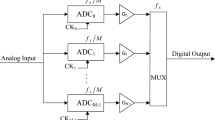Abstract
In this paper an estimation method for timing offset in time-interleaved analog-to-digital convertors (TIADCs) is proposed. The method is based on the estimation of relative timing offset between two consecutive channels. The least-mean-squares algorithm is used for estimating relative timing offsets. The convergence analysis is accomplished using frequency domain representation of the signals. The method can be used for arbitrary channel TIADCs due to using an anti-aliasing filter. Also, a non-sequential estimation method based on estimated differential delays is proposed at the end.











Similar content being viewed by others
Abbreviations
- \(x_{c}(t)\) :
-
Continuous time signal
- \(x{[n]}\) :
-
Discrete time signal
- \(\tilde{x}_{i}{[n]}\) :
-
The output signal in channel \(i\)
- \(f_{i}{[n]}\) :
-
Impulse response of the analysis filter
- \(Lp(e^{j\omega })\) :
-
Anti-aliasing filter
- \(F_{i}(e^{j\omega })\) :
-
Frequency response of the analysis filter
- \(\varDelta \delta _{i+1}\) :
-
Relative timing offset
- \(h{[n,\varDelta \hat{\delta }_{i+1}]}\) :
-
Fractional delay filter impulse response
- \(L(e^{j\omega })\) :
-
Low-pass filter frequency response
- \(D(e^{j\omega })\) :
-
Differentiator filter frequency response
- \(e{[n,\varDelta \hat{\delta }_{i+1}]}\) :
-
Error signal
- \(J{[\varDelta \hat{\delta }_{i+1}]}\) :
-
Objective function
- \(P\) :
-
Power of differentiated signal
- \(\mu \) :
-
Step size
- \(\epsilon _{i}\) :
-
Estimation error of relative timing offset
- \(\gamma _{i}\) :
-
Estimation error of timing offset
- \(\theta _{i}\) :
-
Time delay in channel \(i\)
- \(p(i,j)\) :
-
Differential delay between channel \(i\) and \(j\)
- \(\varvec{A}\) :
-
Sparse matrix
- \(\hat{\varvec{\theta }}\) :
-
Estimated delay vector
References
Conroy, C.S., Cline, D.W., Gray, P.R.: An 8-b 85-MS/s parallel pipeline A/D converter in 1-T m CMOS. In: IEEE J. Solid-State Circuits 28(4), 447–454 (1993)
Nakamura, K., Hotta, M., Carley, L.R., Allstot, D.J.: An 85 mW, 10b, 40 Msample/s CMOS parallel-pipelined ADC. In: IEEE J. Solid-State Circuits 30(3), 173–183 (1995)
Fu, D., Dyer, K.C., Lewis, S.H., Hurst, P.J.: A digital background calibration technique for time-interleaved analog-to-digital converters. In IEEE J. Solid-State Circuits 33(12), 1904–1911 (1998)
Jamal, S.M., Fu, D., Chang, N.C.-J., Hurst, P.J., Lewis, S.H.: A 10-b 120-msample/s time-interleaved analog-to-digital converter with digital background calibration. In: IEEE J. Solid-State Circuits 37(12), 1618–1627 (2002)
Poulton, K., Neff, R., Muto, A., Liu, W., Burstein, A., Heshami, M.: A 4 Gsample/s 8b ADC 0.35 m CMOS. In: Presented at the: Digital Technology Seminar on Solid State, San Francisco, CA, USA. Feb. 21–22 (2002)
Poulton, K., Neff, R., Setterberg, B., Wuppermann, B., Kopley, T., Jewett, R., Pernillo, J., Tan, C., Montijo, A.: A 20 GS/s 8b ADC with a 1 MB memory in 0.18 m CMOS. In: Presented at the: Digital Technology Seminar on Solid State, San Francisco, CA, USA. Feb. 21–22 (2003)
Huang, S., Levy, B.C.: Adaptive blind calibration of timing offset and gain mismatch for two-channel time-interleaved ADCs. IEEE J. Circuits Syst. 53(6), 1280–1283 (2006)
Johansson, H., Löwenborg, P.: Reconstruction of nonuniformly sampled bandlimited signals by means of digital fractional delay filters. IEEE Trans. Signal Process. 50(11), 2757–2767 (2002)
Prendergast, R.S., Levy, B.C., Hurst, P.J.: Reconstruction of bandlimited periodic nonuniformly sampled signals through multirate filter banks. IEEE Trans. Circuits Syst. I Fundam. Theory Appl. 51(8), 1612–1622 (2004)
Elbornsson, J., Gustafsson, F., Eklund, J.: Blind equalization of time errors in a time-interleaved ADC system. IEEE Trans. Signal Process. 53, 1413–1424 (2005)
Seo, M., Rodwell, M.J.W., Madhow, U.: A low computation adaptive blind mismatch correction for time-interleaved ADCs. In: Presented at the: Digital Technology Seminar on Circuits and Systems, vol. 1, pp. 292–296. San Juan, MWSCA. Aug. 6–9 (2006)
Huang, S., Levy, B.C.: Blind calibration of timing offsets for four-channel time-interleaved ADCs. IEEE J. Circuits Syst. 54(4), 866–871 (2007)
Bienati, N., Spagnolini, U.: Multidimensional wavefront estimation from differential delays. IEEE Trans. Geosci. Remote Sens. 39(3), 655–664 (2001)
Proakis, J.G., Manolakis, D.G.: Digital Signal Processing, Ch. 13. Prentice Hall, New Jersey (2007)
Golub, G.H., Van Loan, C.F.: Matrix Computations. Prentice Hall, 2nd Edition by Johns Hopkins University Press Ltd., London (1989)
Meurant, G.: Computer Solution of Large Linear Systems. Elsevier Science, Amsterdam (1999)
Saad, Y: Iterative Methods for Sparse Linear Systems, 2nd Edition with corrections by Stanford University Press, Ch. 9, pp. 245–260 (2000)
Author information
Authors and Affiliations
Corresponding author
Appendix: The derivation of convergence analysis
Appendix: The derivation of convergence analysis
The proof for the convergence analysis proposed in Sect. 3 is presented in this part. The first expectation term presented in (26) is
Replacing \(\tilde{x}_{i+1}[n]\) by
where \(h[n,\varDelta \delta _{i+1}]\) is defined in (20), we obtain
Based on the general Parsevals’ identity for real-time sequences \(a[n]\) and \(b[n]\)
Note that because \(b[n]\) is a real-time sequence, its conjugate is equal to itself or \(b^{\star }[n]=b[n]\). In (62), \(A(\omega )\) and \(B^{\star }(\omega )\) are the DTFT of \(a[n]\) and the conjugate of the DTFT of \(b[n]\), respectively. Applying (64) to (61) leads to
That is because the first expectation term in (63) can be written as
Replacing \(L(e^{j\omega })\) and \(D(e^{j\omega })\) from (13) and (14), respectively, and a simple calculation, we find
Note that in (67) the integrand is an odd function, so the result is zero. The second expectation term in (61) can be written as
Replacing \(D(e^{j\omega })\) from (14) and a simple calculation, we obtain
or equivalently,
Replacing (67) and (70) in (63) results (65).
The second expectation term presented in (26) is
Note that like in (67) the result is zero because the integrand is an odd function. Finally, the third expectation term in (26) is
Note that like in (70) the result is \(P\). Substituting (65), (71), and (72) in (26) results in (27).
Rights and permissions
About this article
Cite this article
Shahmansoori, A. Consecutive adaptive blind estimation of timing offsets for arbitrary channel time-interleaved ADCs. SIViP 9, 45–55 (2015). https://doi.org/10.1007/s11760-012-0405-2
Received:
Revised:
Accepted:
Published:
Issue Date:
DOI: https://doi.org/10.1007/s11760-012-0405-2




